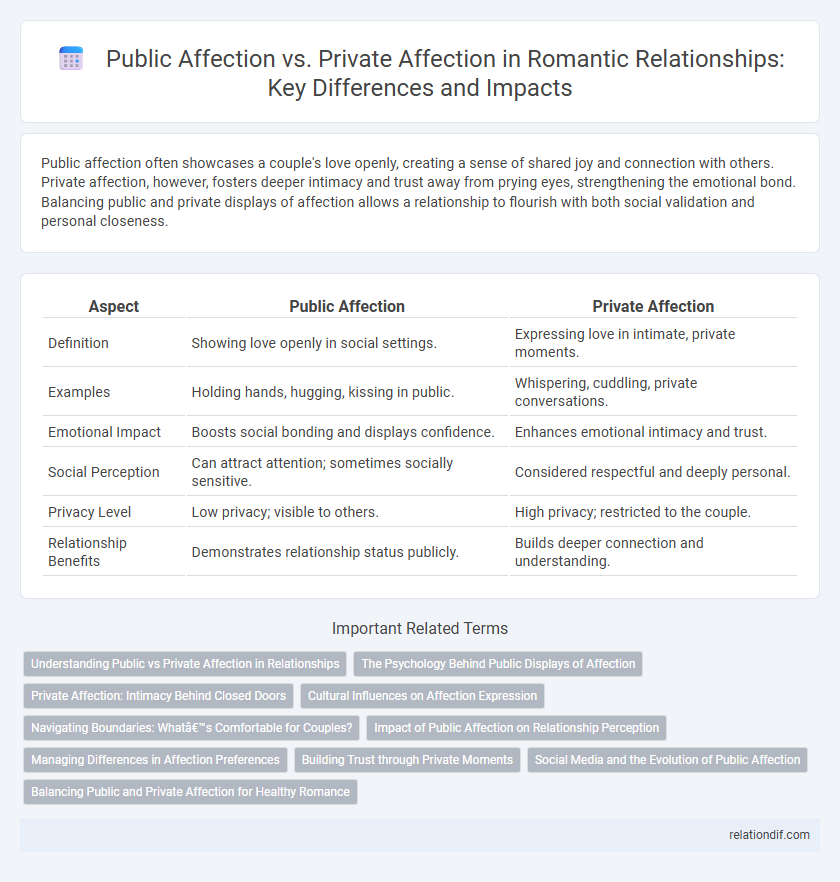Public affection often showcases a couple's love openly, creating a sense of shared joy and connection with others. Private affection, however, fosters deeper intimacy and trust away from prying eyes, strengthening the emotional bond. Balancing public and private displays of affection allows a relationship to flourish with both social validation and personal closeness.
Table of Comparison
| Aspect | Public Affection | Private Affection |
|---|---|---|
| Definition | Showing love openly in social settings. | Expressing love in intimate, private moments. |
| Examples | Holding hands, hugging, kissing in public. | Whispering, cuddling, private conversations. |
| Emotional Impact | Boosts social bonding and displays confidence. | Enhances emotional intimacy and trust. |
| Social Perception | Can attract attention; sometimes socially sensitive. | Considered respectful and deeply personal. |
| Privacy Level | Low privacy; visible to others. | High privacy; restricted to the couple. |
| Relationship Benefits | Demonstrates relationship status publicly. | Builds deeper connection and understanding. |
Understanding Public vs Private Affection in Relationships
Understanding the distinction between public and private affection is essential for nurturing trust and intimacy in relationships. Public displays of affection often reflect a partner's comfort level and social boundaries, signaling commitment to others, while private affection fosters deeper emotional connection through personal, vulnerable moments. Balancing these expressions helps couples respect individual preferences and strengthens relational dynamics beyond external perceptions.
The Psychology Behind Public Displays of Affection
Public displays of affection (PDA) often serve as a psychological tool to signal relationship status and reinforce emotional bonds in a social context, reflecting underlying desires for validation and security. Individuals may use PDA to communicate attachment levels, boost self-esteem, or foster group belonging, with varying comfort dictated by personal boundaries and cultural norms. Understanding the psychology behind PDA reveals how couples navigate the balance between intimacy expression and social perception, highlighting the nuanced impact on relationship satisfaction.
Private Affection: Intimacy Behind Closed Doors
Private affection fosters a deeper emotional bond through intimate gestures shared away from the public eye, enhancing trust and vulnerability between partners. The privacy of these moments allows couples to express genuine feelings without external judgment or distraction, strengthening their connection. This intimate setting encourages open communication, promoting emotional security and lasting romantic fulfillment.
Cultural Influences on Affection Expression
Cultural norms significantly shape how affection is expressed in public versus private settings, with some societies embracing public displays of affection (PDA) as a natural part of romantic relationships, while others view them as inappropriate or taboo. In collectivist cultures like Japan and India, private affection holds greater importance, emphasizing subtle gestures and emotional intimacy within close family or partner circles. Western cultures, particularly in Europe and North America, tend to normalize PDA such as holding hands, hugging, or kissing, reflecting broader values of individualism and personal freedom in romantic expression.
Navigating Boundaries: What’s Comfortable for Couples?
Couples often find comfort in balancing public affection and private intimacy, tailoring their displays of love to personal boundaries and social settings. Understanding each partner's preferences helps navigate moments of affection, ensuring respect and emotional safety in both public and private spaces. Open communication about these boundaries strengthens connection and fosters mutual comfort.
Impact of Public Affection on Relationship Perception
Public affection significantly shapes how partners are perceived by others, often signaling relationship status and emotional closeness. Displays of affection in public can strengthen a couple's bond by fostering social validation and increasing feelings of security and belonging. However, excessive or insincere public affection may lead to misinterpretations, affecting trust and authenticity within the relationship.
Managing Differences in Affection Preferences
Managing differences in public versus private affection preferences requires open communication and mutual respect within a romantic relationship. Partners often navigate varying comfort levels with physical touch or verbal expressions of love in social settings compared to intimate moments. Establishing boundaries that honor each person's needs fosters trust and emotional connection while reducing potential misunderstandings.
Building Trust through Private Moments
Private affection fosters deeper emotional connections by allowing partners to express vulnerability without external judgment, thereby building a solid foundation of trust. Intimate moments away from the public eye encourage authentic communication and reinforce mutual understanding. Trust cultivated in private settings supports a healthier and more resilient romantic relationship.
Social Media and the Evolution of Public Affection
Public displays of affection have transformed significantly with the rise of social media platforms like Instagram and TikTok, where couples often share intimate moments to express their relationships publicly. This digital evolution blurs the boundaries between private affection and public perception, influencing societal norms around romance and intimacy. Research from the Journal of Social and Personal Relationships highlights that online public affection can strengthen bonds by fostering social validation but may also increase vulnerability to external judgment.
Balancing Public and Private Affection for Healthy Romance
Balancing public and private affection strengthens romantic relationships by fostering trust and emotional intimacy while respecting personal boundaries. Public displays of affection, such as holding hands or brief kisses, signal commitment and affection to others, enhancing social support for the couple. Private moments of intimacy deepen connection and allow partners to express vulnerability, which is essential for maintaining a healthy, enduring romance.
public affection vs private affection Infographic

 relationdif.com
relationdif.com